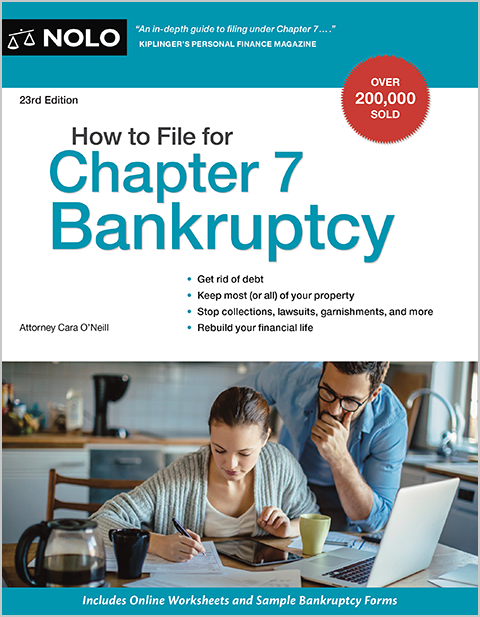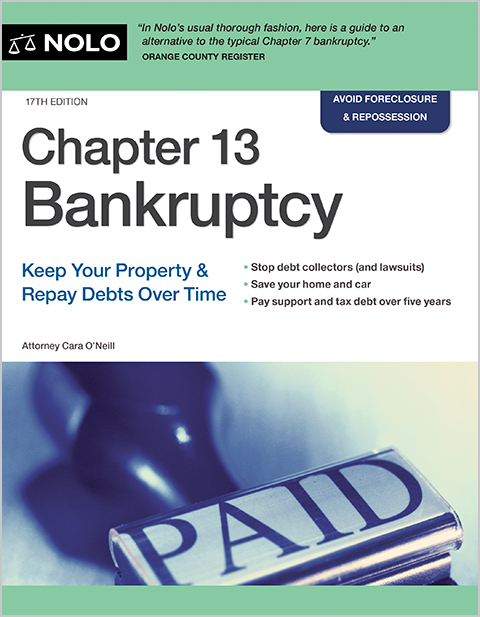Understand the risks faced by cosigners during bankruptcy.
If you have cosigners or guarantors on your debts, your decision to file for bankruptcy could affect them. However, there are ways to prevent creditors from pursuing your codebtors if you file for bankruptcy. In this article, you'll learn when a lender will require a cosigner, and more, including what happens to your cosigner if you file for Chapter 7 bankruptcy, what happens to your cosigner in Chapter 13 bankruptcy, a bankruptcy filing's impact on a cosigner's credit, and your responsibilities if your cosigner files for bankruptcy.
Read on to learn more about how bankruptcy impacts the obligation of your cosigners and guarantors to pay your debts and what you can do to protect them.
- What Is a Cosigner?
- Cosigners and Guarantors
- When Will a Creditor Require a Cosigner?
- What Happens to a Cosigner If I File for Bankruptcy?
- What Can I Do to Protect a Cosigner If I File for Chapter 7?
- How Filing for Chapter 7 or 13 Bankruptcy Affects a Cosigner's Credit
- FAQ: Cosigner's Rights and Responsibilities
- Need More Bankruptcy Help?
What Is a Cosigner?
A cosigner is someone who agrees to take responsibility for a debt, such as a car loan or a rental obligation, along with the borrower. This typically happens when the borrower lacks the ability to qualify on their own merit due to poor or limited credit.
A cosigner is affected by the loan in much the same way as the borrower. The cosigner can make monthly payments on behalf of the borrower, and the lender can collect missed payments from either the cosigner or the borrower. The cosigner's credit also reflects the account activity.
Cosigners and Guarantors
A guarantor also guarantees the payment of a borrower's debt. However, a guarantor isn't involved in monthly debt payments. Instead, the lender can collect the guaranteed debt in full if the borrower fails to pay.
When Will a Creditor Require a Cosigner?
Lenders who doubt a borrower's ability to repay a loan will often require someone with higher income, more assets, or better credit to assume responsibility along with the borrower. For instance, a bank might ask for a cosigner for any of the following reasons:
- You have little credit history that the bank can use to judge your ability to satisfy your obligations.
- Your credit isn't perfect, or you've filed for bankruptcy.
- You can't put up collateral to secure the loan.
- You want to borrow more than you can afford to repay.
- You're borrowing the money for your business (in which case, you might be asked to guarantee the loan with your personal assets—called a personal guarantee).
A cosigner might be required in other situations, as well. For instance, landlords ask first-time renters or those with past credit issues to have someone guarantee the obligation. The same applies when leasing a vehicle, equipment, and furniture.
What Happens to a Cosigner If I File for Bankruptcy?
Your bankruptcy discharge eliminates your responsibility to pay your debts, not the liability of the cosigners and guarantors to pay the debt. Whether a creditor can collect from the cosigner during bankruptcy depends on whether you file Chapter 7 or 13.
What Happens to My Cosigner If I File for Chapter 7?
If you file for Chapter 7 bankruptcy, your cosigner won't receive any protection from creditors. They'll still be on the hook during and after bankruptcy.
All collection activities against you must stop because of the bankruptcy's automatic stay. However, the automatic stay doesn't extend to your cosigners, and your debt discharge won't impact a cosigner's payment responsibilities. Your creditors will be free to pursue the cosigner or guarantor of your debt.
What Happens to My Cosigner If I File for Chapter 13?
A Chapter 13 bankruptcy offers more protection to your cosigners and guarantors. Plus, you get more time to pay off the cosigned or guaranteed debt through your three- to five-year Chapter 13 repayment plan.
When you file a Chapter 13, the automatic stay protects cosigners and guarantors from creditors collecting on consumer (nonbusiness) debts—called the Chapter 13 codebtor stay. Your creditors can still ask the court to lift the automatic stay under the following circumstances:
- Your cosigner or guarantor received the consideration (benefit of the deal) for the creditor's claim.
- You aren't proposing to pay the debt in full through your Chapter 13 plan.
- The creditor will suffer irreparable harm if the stay remains in place, usually by losing money.
Also, the codebtor stay will end if the court dismisses your case or converts the case from Chapter 13 to Chapter 7 bankruptcy.
What Can I Do to Protect a Cosigner If I File for Chapter 7?
You can take steps to protect your cosigners and guarantors from collection efforts by creditors when you file for Chapter 7. Here are your options.
Reaffirm the Debt
Before receiving a discharge in Chapter 7, you can choose to reaffirm secured debts such as car loans, mortgages, and other certain other credit accounts (jewelry, computer, and furniture accounts are often secured by the purchased product, meaning that you must return it if you fail to pay as agreed).
When you reaffirm a debt, you give up the benefit of your discharge and make yourself personally liable for the obligation again. As a result, reaffirming debts isn't usually advised unless you need a particular item or want to help protect cosigners and guarantors from creditors.
To learn more, see Reaffirming Secured Debt in Chapter 7 Bankruptcy.
Pay Off the Debt
After a Chapter 7 discharge, you are no longer obligated to pay back any discharged debts. However, this does not preclude you from voluntarily paying off your debts after the bankruptcy.
If you want to protect your cosigners and guarantors, you can continue making payments on the debt until it is paid. In many cases, such as with an automobile, the lender will allow you to continue making the monthly payment. You can read more about keeping cars in Chapter 7 bankruptcy.
Warning about guarantors. It would be highly unusual for a typical bankruptcy filer to have a guarantor on an auto loan or some other secured purchase. However, a lender might not be willing to informally accept monthly payments if a guarantor were in place and had sufficient assets to pay the debt in full.
Important tip. You probably won't want to pay off the debt before filing for bankruptcy. Bankruptcy rules prevent you from favoring one creditor over another, and the bankruptcy trustee could unwind the transaction. Learn about preferential transfers in bankruptcy.
How Filing for Chapter 7 or 13 Bankruptcy Affects a Cosigner's Credit
Bankruptcy affects the credit of the person who files for bankruptcy, regardless of the cosigner's status. The bankruptcy filing won't impact the nonfiling cosigner's credit directly. Here's how it works.
You file for bankruptcy. If you file for bankruptcy, your debt responsibility will be eliminated—assuming the debt can be discharged—and your credit score will likely decrease. Nonfiling cosigners remain responsible for the debt. A nonfiling cosigner's credit won't be affected unless the cosigner doesn't pay the debt.
Your cosigner files for bankruptcy. Suppose your cosigner files for bankruptcy. In that case, the bankruptcy will wipe out the cosigner's responsibility to pay and impact the cosigner's credit. You'll remain responsible for the debt. Your credit won't decrease unless you stop paying as required.
Learn about bankruptcy and your credit.
FAQ: Cosigner's Rights and Responsibilities
Here are some other questions you might have about cosigner's rights & responsibilities
- Can a cosigner demand payment from the primary borrower if the borrower defaults and the cosigner must pay?
- Is the cosigner involved in the borrower's bankruptcy?
- Can a cosigner be removed from a loan?
- What steps should a cosigner take to protect against future payment risks?
- Is it true that if the borrower misses a payment, the cosigner's credit score will be affected?
Can a cosigner demand payment from the primary borrower if the borrower defaults and the cosigner must pay?
Yes, the cosigner can typically sue the borrower for the amount paid by the cosigner. However, a borrower's payment liability to a cosigner is discharged in bankruptcy along with other qualifying debts. Therefore, the cosigner's ability to collect ceases with the bankruptcy filing.
Is the cosigner involved in the borrower's bankruptcy?
Typically, no, aside from the ongoing responsibility to pay the debt during and after bankruptcy, even if the borrower receives a discharge. An exception might arise if the cosigner believes their payment obligation resulted from the borrower's fraudulent behavior. In such a case, the cosigner could request that the court not discharge the borrower's obligation to them. However, this would be a rare situation.
Can a cosigner be removed from a loan?
A lender won't voluntarily remove a cosigner from a loan. However, a borrower could refinance the loan without the cosigner before bankruptcy. The cosigner's obligation would be eliminated, even if the borrower later filed for bankruptcy.
What steps should a cosigner take to protect against future payment risks?
The only foolproof way to avoid payment risk is not to cosign a loan. Other than that, only agree to cosign for responsible individuals who can pay the debt.
Is it true that if the borrower misses a payment, the cosigner's credit score will be affected?
Yes. You should monitor the account regularly because you might need to make payments if the borrower can't if you want to avoid damaging your credit.
Need More Bankruptcy Help?
Did you know Nolo has made the law accessible for over fifty years? It's true, and we wholeheartedly encourage research and learning. You can find many more helpful bankruptcy articles on Nolo's bankruptcy homepage. For instance, Nolo articles will explain what bankruptcy can do, what you'll want to avoid before filing for bankruptcy, and more. Information needed to complete the official downloadable bankruptcy forms is on the Department of Justice U.S. Trustee Program website.
However, online articles and resources can't address all bankruptcy issues and aren't written with the facts of your particular case in mind. The best way to protect your assets in bankruptcy is by hiring a local bankruptcy lawyer.
|
|
- What Is a Cosigner?
- Cosigners and Guarantors
- When Will a Creditor Require a Cosigner?
- What Happens to a Cosigner If I File for Bankruptcy?
- What Can I Do to Protect a Cosigner If I File for Chapter 7?
- How Filing for Chapter 7 or 13 Bankruptcy Affects a Cosigner’s Credit
- FAQ: Cosigner's Rights and Responsibilities
- Need More Bankruptcy Help?

